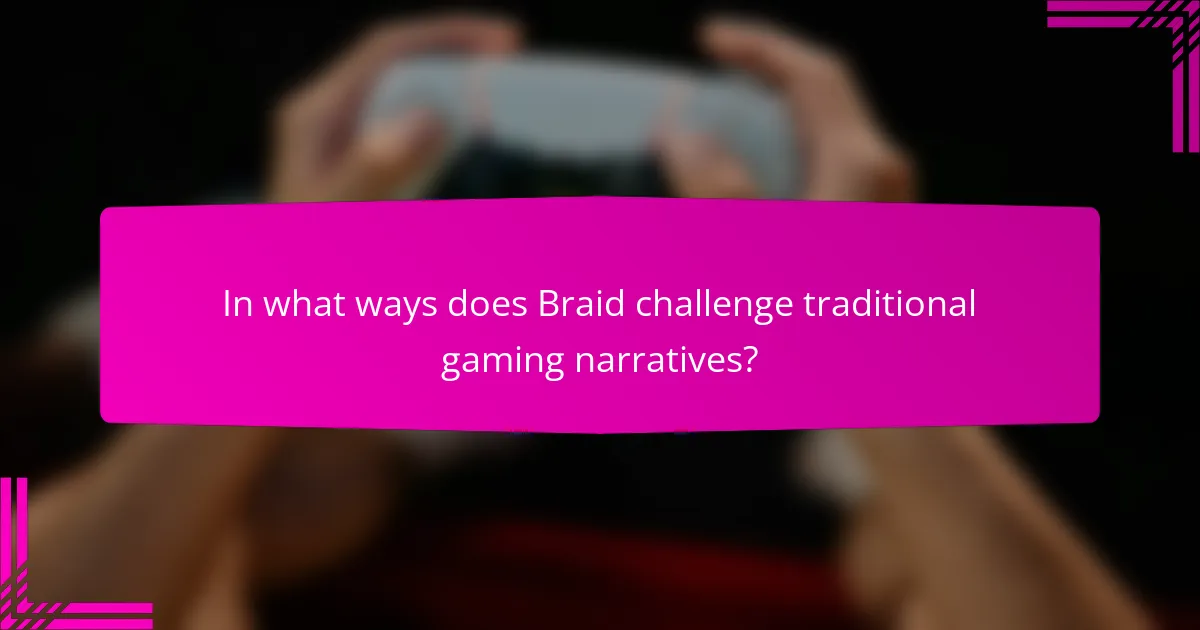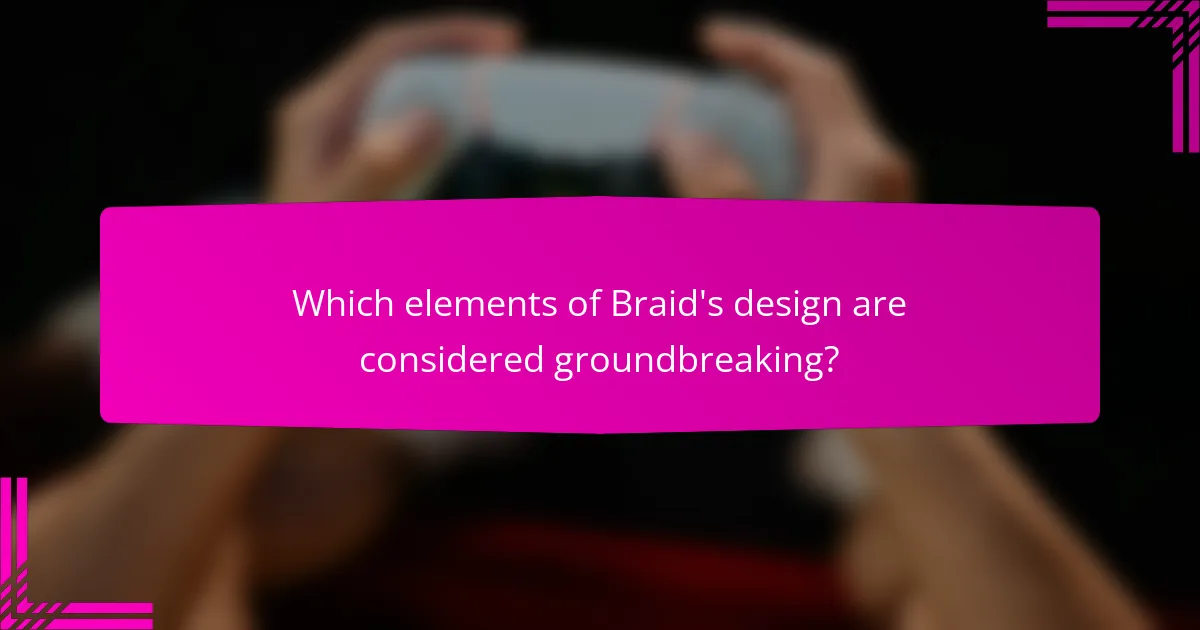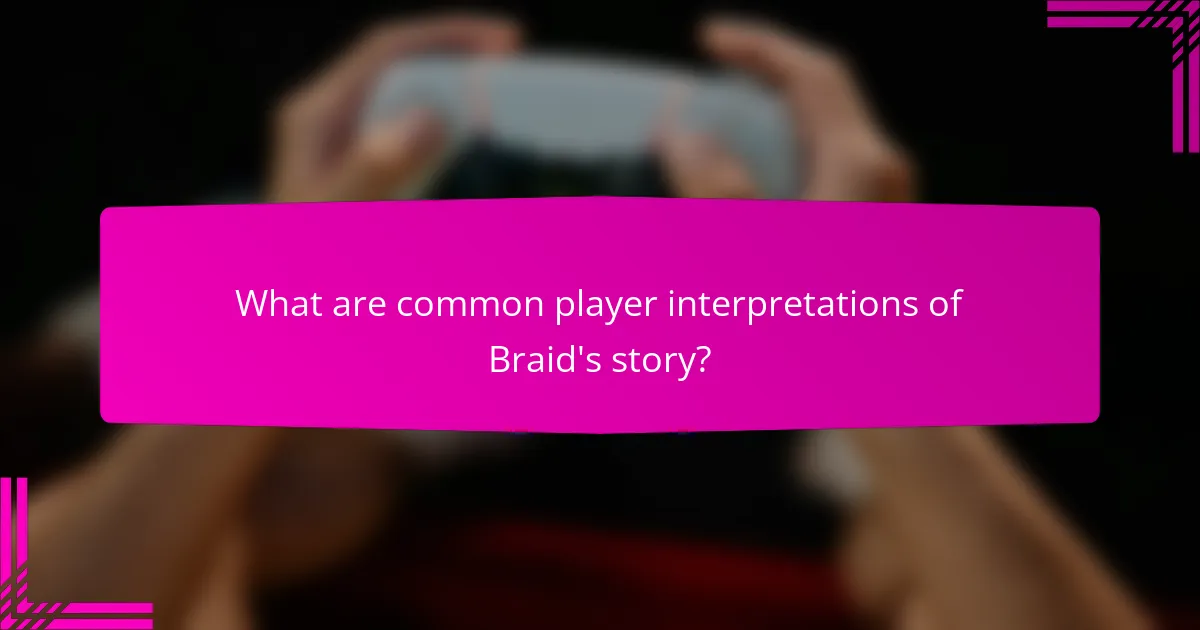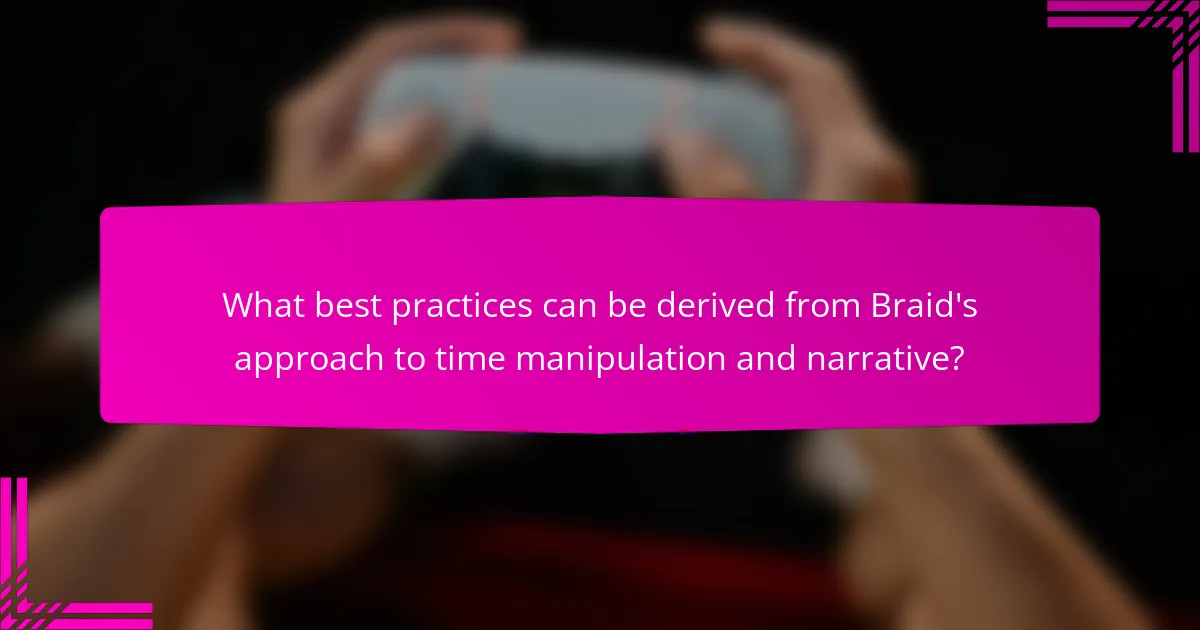Braid’s innovative time manipulation mechanics redefine gameplay and narrative engagement. The game features non-linear storytelling, emphasizing puzzle-solving and player agency. It explores themes of regret and personal growth, intertwining emotional storytelling with unique mechanics. The art style and music further enhance the immersive experience, challenging conventional gaming narratives.

How does Braid utilize time manipulation mechanics?
Braid employs time manipulation mechanics to enhance gameplay and narrative depth. Players can rewind time to solve puzzles, allowing for unique interactions with the environment. This mechanic emphasizes the consequences of actions, creating a rich narrative experience. Time manipulation enables players to explore multiple outcomes, deepening engagement with the storyline. The game’s structure intertwines these mechanics with emotional storytelling, making time a central theme in both gameplay and narrative progression.
What are the core gameplay mechanics of time manipulation in Braid?
Braid’s core gameplay mechanics of time manipulation include rewinding time, creating time-based puzzles, and altering the flow of time. Players can reverse their actions, allowing for strategic planning and experimentation. The unique attribute of this mechanic is its integration with the narrative, where time manipulation reflects themes of regret and consequence. Each level introduces new challenges that require players to think critically about time’s role in problem-solving.
How do different levels integrate time mechanics uniquely?
Different levels in Braid integrate time mechanics by using unique narrative structures and gameplay dynamics. Each level introduces distinct time manipulation techniques, such as rewinding or pausing time, which affect puzzle-solving and story progression. For instance, the first level emphasizes basic time reversal, while later levels combine multiple mechanics, creating complex interactions. This layered approach enhances player engagement and deepens the narrative experience, demonstrating how time is not just a mechanic but a core element of storytelling. Each level’s unique integration of time mechanics contributes to a cohesive and immersive gameplay experience.
Which puzzles exemplify Braid’s innovative use of time?
Braid exemplifies innovative use of time through its unique puzzles that manipulate temporal mechanics. One notable puzzle involves reversing time to solve challenges, allowing players to retrace their steps and adjust their actions. Another puzzle showcases time dilation, where players must navigate through layers of time to progress. The game also features a narrative that intertwines with these mechanics, enhancing the player’s understanding of time’s fluidity. Overall, Braid’s puzzles redefine conventional gameplay by integrating time as a core element of both challenge and storytelling.
How does time manipulation affect player strategy and decision-making?
Time manipulation in Braid significantly influences player strategy and decision-making by allowing players to reverse actions and experiment with outcomes. This mechanic encourages creative problem-solving and strategic planning, as players can undo mistakes and explore multiple solutions.
The unique attribute of Braid’s time mechanics is its narrative integration, where time manipulation reflects the protagonist’s emotional journey. Players must consider not only immediate actions but also the broader implications of their choices, enhancing engagement and depth in gameplay.
As a result, players develop a more thoughtful approach, weighing risks and rewards. This leads to a richer gaming experience, as each decision can alter the game’s narrative and mechanics. The interplay of strategy and story fosters a unique engagement, setting Braid apart from traditional platformers.

What narrative techniques are employed in Braid?
Braid employs various narrative techniques, primarily through its unique time manipulation mechanics. The game uses non-linear storytelling, allowing players to experience events out of chronological order, creating a complex narrative structure. Additionally, the use of puzzles reinforces the themes of time and consequence, requiring players to think critically about their actions. The character of Tim serves as a focal point, with his motivations revealed gradually, enhancing emotional engagement. Symbolism is prevalent, particularly in the representation of time as both a tool and a barrier.
How does the story structure enhance the gameplay experience?
The story structure in Braid significantly enhances gameplay by intertwining narrative and time manipulation mechanics. This integration creates a deeper emotional connection and encourages players to reflect on their actions. The unique attribute of non-linear storytelling allows players to experience events from different perspectives, enriching the overall experience. Additionally, the mechanics of rewinding time serve as a rare attribute, enabling players to explore consequences and solutions, thus reinforcing the narrative’s themes of regret and redemption. This synergy between story and gameplay fosters a more immersive and thought-provoking experience.
What role does character development play in the narrative?
Character development is crucial in Braid as it deepens the narrative through time manipulation mechanics. The protagonist’s journey reflects personal growth, enhancing emotional engagement. This interplay between character and mechanics allows players to experience the consequences of choices, reinforcing themes of regret and redemption. Unique narrative techniques, such as non-linear storytelling, further enrich character arcs, making them integral to the overall experience.
How do visual and audio elements contribute to storytelling?
Visual and audio elements enhance storytelling by creating immersive experiences and emotional connections. In “Braid,” time manipulation mechanics are complemented by visual aesthetics and sound design, enriching the narrative. The unique attribute of its art style visually conveys themes of time and memory, while the audio elements, including music and sound effects, deepen emotional engagement. As a result, players experience a cohesive story where gameplay mechanics and sensory elements intertwine, reinforcing the overall narrative impact.

In what ways does Braid challenge traditional gaming narratives?
Braid challenges traditional gaming narratives through innovative time manipulation mechanics and a non-linear storytelling approach. The game allows players to rewind time, creating a unique gameplay experience that emphasizes puzzle-solving over conventional action sequences. This mechanic invites deeper engagement with the narrative, as players must reconsider their actions and their consequences.
Additionally, Braid subverts expectations by presenting themes of regret and personal growth, diverging from typical hero narratives. The art style and music further enhance the emotional depth, creating a cohesive experience that encourages reflection on the nature of time and choice. This combination of mechanics and narrative techniques positions Braid as a significant departure from mainstream gaming conventions.
How does the ending of Braid subvert player expectations?
The ending of Braid subverts player expectations by revealing the true nature of time manipulation. Players initially perceive the mechanics as a means to solve puzzles, but the conclusion recontextualizes these mechanics as a metaphor for regret and the futility of trying to change the past. This twist challenges players’ assumptions about success and failure, emphasizing the emotional weight of choices rather than mere gameplay achievements. The narrative intertwines with gameplay, making the ending both a revelation and an emotional commentary on the consequences of one’s actions.
What themes are explored through the game’s narrative and mechanics?
Braid explores themes of time, regret, and the consequences of choices through its unique time manipulation mechanics. The narrative intertwines with gameplay, emphasizing how actions affect outcomes. Players experience the impact of time as they solve puzzles, reflecting on the nature of memory and perception. The mechanics encourage contemplation of how time influences relationships and personal growth.

Which elements of Braid’s design are considered groundbreaking?
Braid’s design is groundbreaking due to its innovative time manipulation mechanics and narrative techniques. The ability to rewind time allows players to solve puzzles in unique ways, creating a dynamic gameplay experience. Its narrative structure intertwines gameplay and story, challenging traditional storytelling in video games. The game employs a non-linear narrative that deepens emotional engagement, setting it apart from contemporaries. Additionally, the art style combines classic aesthetics with modern design, enhancing its distinctive identity.
How has Braid influenced other indie games and developers?
Braid has significantly influenced indie games and developers by popularizing time manipulation mechanics and narrative depth. Its innovative gameplay mechanics have inspired titles like “The Witness” and “Celeste,” which incorporate similar puzzle-solving elements. Braid’s unique narrative techniques, blending gameplay with storytelling, have encouraged developers to explore unconventional narratives, enhancing the emotional engagement in games. As a result, many indie developers now prioritize creative mechanics and storytelling, reflecting Braid’s impact on the industry.
What unique artistic choices set Braid apart from other platformers?
Braid distinguishes itself through innovative time manipulation mechanics and a narrative structure that intertwines gameplay with storytelling. The game allows players to rewind time, providing unique puzzle-solving opportunities that challenge traditional platforming conventions. Additionally, its narrative unfolds non-linearly, encouraging players to reflect on the consequences of their actions. This integration of mechanics and story deepens player engagement and sets Braid apart from typical platformers.

What are common player interpretations of Braid’s story?
Players often interpret Braid’s story as a reflection on regret and the complexity of relationships. Many see the narrative as an exploration of the consequences of time manipulation, emphasizing how choices affect outcomes. Some players highlight the unique storytelling techniques, such as the non-linear progression, which reinforces the theme of revisiting past mistakes. Others focus on the protagonist’s quest for redemption, interpreting the journey as a metaphor for personal growth and understanding. The game’s ending prompts varied discussions, with some players viewing it as a twist that recontextualizes the entire experience.
How do cultural perspectives influence the understanding of Braid’s themes?
Cultural perspectives significantly shape the understanding of Braid’s themes by influencing interpretations of time and choice. Different cultures perceive time either linearly or cyclically, affecting how players engage with the game’s mechanics. For instance, Western cultures often view time as a sequential progression, which aligns with the game’s narrative structure. Conversely, cultures with a cyclical view may interpret the time manipulation mechanics as a reflection of life’s repetitive nature. Additionally, cultural narratives surrounding personal agency and consequence can alter how players perceive the impact of their decisions within the game. These diverse interpretations enrich the overall experience and highlight the game’s thematic complexity.
What discussions have emerged around Braid’s narrative and mechanics?
Braid’s narrative and mechanics have sparked discussions about their innovative approach to storytelling and gameplay. The game intertwines time manipulation with a deep narrative, challenging conventional game design. Players engage with puzzles that require strategic use of time control, reflecting themes of regret and redemption. Critics highlight how this blend enhances emotional depth and player agency, offering a unique gaming experience. The mechanics not only serve gameplay but also reinforce the narrative, prompting players to reflect on their choices and consequences.

What best practices can be derived from Braid’s approach to time manipulation and narrative?
Braid’s approach showcases best practices in narrative and time manipulation through non-linear storytelling and player agency. These techniques enhance engagement and emotional investment.
1. Embrace non-linear narratives to create complexity and intrigue.
2. Allow player choices to influence outcomes, fostering a sense of agency.
3. Use time manipulation as a mechanic to challenge perceptions and problem-solving.
4. Integrate narrative elements with gameplay mechanics for cohesive experiences.
How can game developers apply Braid’s techniques in their own projects?
Game developers can apply Braid’s techniques by integrating time manipulation mechanics and narrative depth into their projects. They should focus on creating puzzles that challenge players’ perceptions of time, allowing for unique gameplay experiences. Additionally, developers can craft narratives that intertwine with gameplay, enhancing emotional engagement.
Implementing non-linear storytelling can also provide players with agency in how they experience the game. By emphasizing player choice and consequence, developers can echo Braid’s approach to narrative design. Lastly, experimenting with visual and auditory cues can deepen the immersive quality of the game, mirroring the aesthetic techniques used in Braid.
What lessons can players learn from Braid’s unique gameplay and storytelling?
Players can learn about the significance of time manipulation and narrative depth from Braid’s gameplay. The game teaches strategic thinking through its unique mechanics, where players must manipulate time to solve puzzles. This encourages players to consider multiple perspectives and approaches to challenges.
Additionally, Braid’s storytelling intertwines with its gameplay, revealing themes of regret and the consequences of choices. Players gain insight into how narrative can enhance emotional engagement, showing that gameplay mechanics can serve a deeper purpose. This integration of mechanics and story illustrates the potential for games to convey complex ideas and emotions effectively.
